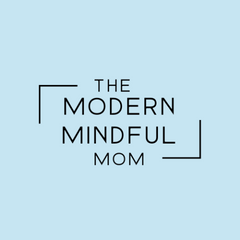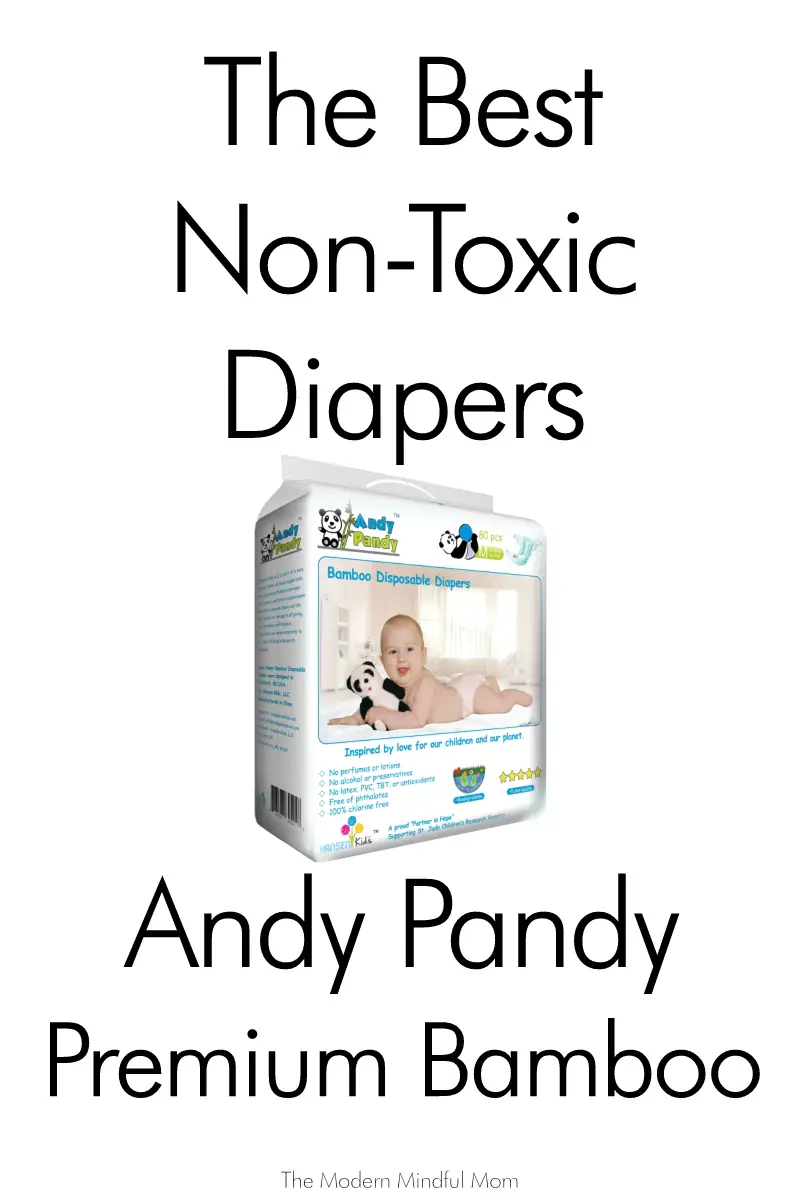The following is a partnered sponsorship with Hansen Kids, LLC. All opinions are my own.
The “Andy Pandy Premium Bamboo” diapers are one of the best non-toxic disposable diapers on the market. They are my top choice and the ones that I use on my little one.
Why non-toxic diapers?
This recommendation is based on hours and hours of research. Now, it shouldn’t be this complicated to find a safe diaper for our babies, but this is the sad reality.
Most brands of disposable diapers contain harmful chemicals, even known carcinogens. This is extremely alarming considering our children wear diapers 24/7 for several years. It’s for this reason that I prioritized finding and using non-toxic diapers.
And I’m not alone. Thankfully, more and more parents seem to be concerned about the chemicals that are found in baby diapers.
As a result, more and more companies are coming out with (self-proclaimed) safer diapers, using claims such as:
- safe
- natural
- non-toxic
- eco-friendly
- green
- clean
However, parents can’t take these claims at face value. These terms aren’t regulated so you have to look at the ingredients. Enter another issue with the diaper industry: Companies are not legally required to disclose their diaper ingredients. Very few companies actually disclose their ingredients.
One brand that does disclose what ingredients are in their diapers is Andy Pandy.
Andy Pandy Premium Bamboo Diapers | Ingredients
Let’s take a look at Andy Pandy’s diaper ingredients. Like all disposable diapers, Andy Pandy diapers are made up of 3 major layers: the topsheet, absorbent core, and backsheet.
Topsheet
The topsheet, or inner lining, is made of non-woven bamboo fiber. Andy Pandy asserts that the bamboo hasn’t been treated with harmful chemical pesticides.
The topsheet is the part of the diaper that touches baby’s skin. Most brands of disposable diapers use polypropylene or polyethylene, a type of plastic made from petroleum. Although these are considered to be some of the ‘safer’ plastics, I personally feel more comfortable with natural fibers touching my baby’s skin.
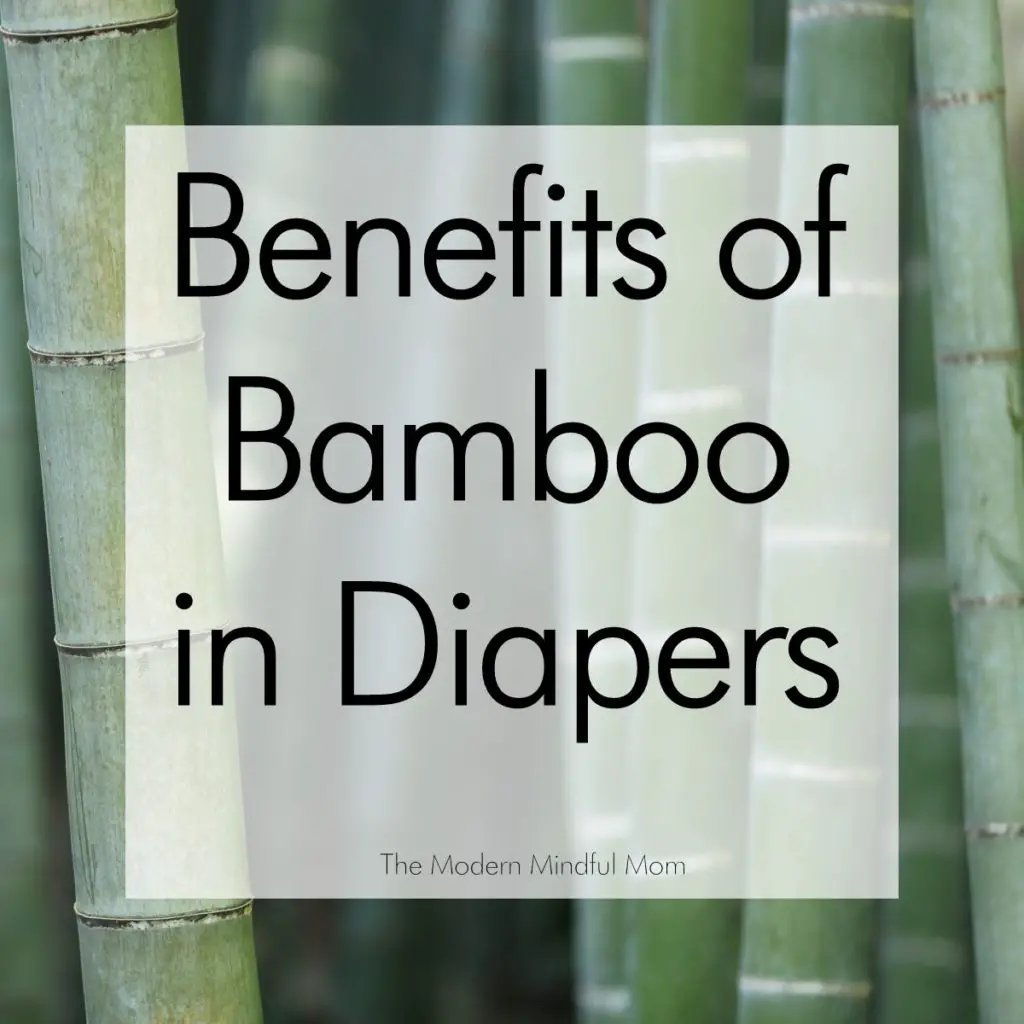
Bamboo has the following properties, making it beneficial for diapers:
- anti-bacterial nature
- high moisture absorption capacity
- softness
Studies have shown bamboo fiber “is highly water absorbent, able to take up three times of its weight of water. Bamboo fibre has [a] natural effect of sterilization, moisture vapour transmission property and easy drying. Therefore, this fibre will not cause skin allergies.”
In addition to being a safe and effective ingredient for diapers, bamboo is an environmentally-friendly choice, especially compared to the plastic alternatives. Bamboo is an extremely fast-growing grass that requires less water than hardwood trees. Additionally, bamboo doesn’t require fertilizers or pesticides, and can regenerate after being harvested without the need for re-planting.
The other ingredient found in the topsheet, or inner lining, of Andy Pandy diapers is pure aloe essence. Andy Pandy states on their website it’s “just a light mist […] to provide nourishment to baby’s skin.” According to the Environmental Working Group, all ingredients listed derived from the aloe plant are considered a low toxicity hazard. I have no concerns with this ingredient.
Absorbent Core
The next layer of the diaper is the absorbent core. The two ingredients in Andy Pandy’s absorbent core are:
1. TCF (Totally Chlorine Free) Fluff Pulp
All disposable diapers contain some type of fluff pulp, but the fact that Andy Pandy’s is “Totally Chlorine Free” makes it a safer option.
Sweden was the first country to develop and commercialize TCF pulp. The other two methods of pulp production involve using elemental chlorine (Cl2) or chlorine dioxide (ClO2) which is referred to as “elemental chlorine free,” or ECF. ECF is the most common pulp production method currently used. The industry moved away from using elemental chlorine after health and environmental concerns came to light.
However, residual chlorine can still be detected in pulp using the ECF process. Another issue I have with ECF pulp is that dioxins are present. Although ECF pulp significantly reduces dioxins compared to using elemental chlorine, it does not eliminate them. This is problematic because dioxins
“have been linked to various types of cancers, respiratory problems, cardiovascular diseases, neurological diseases, and reproductive disorders. They have garnered attention not only due to their toxic properties but also because of their tendency to remain in the environment for long periods of time and accumulate in the bodies of animals and humans.”
The TCF process completely eliminates the use of both Cl2 and ClO2 and instead typically uses hydrogen peroxide (H2O2) and/or ozone (O3). As a result, this “eliminates dioxins and chlorinated toxic pollutants by not producing them in the first place.”
2. SAP
Superabsorbent polymer, or SAP, is used in practically every disposable diaper. It is studied to be safe and non-toxic.
A leading chemical firm, McDonough Braungart Design Chemistry, has assigned SAP with a “GREEN” label, which is the safest assessment a chemical or material can receive. The Environmental Protection Agency has even declared that SAP is harmless when ingested. Further, the Danish EPA determined in regards to SAP that “no serious adverse effects were observed by oral, dermal or pulmonal administration.”
The “Sumitomo” Andy Pandy mentions on their website is in reference to the Sumitomo Chemical Company, a world leading supplier of SAP.
Backsheet
The backsheet is the outermost layer of the diaper. Andy Pandy’s backsheet is made of 100% non-woven bamboo fiber, the same material found in the topsheet.
Remaining Ingredients
The remaining ingredients as disclosed by Andy Pandy on their website are as follows:
- Elastic (in the waistband and around the legs)
- Velcro tape
- Adhesive
- PH Strip (Wetness Indicator)
I don’t take issue with any of these ingredients, especially since Andy Pandy goes one step further and discloses that certain harmful substances are not included in their diapers.
Ingredients Not Found in Andy Pandy Diapers
Andy Pandy discloses that their diapers do not contain any of the following:
- Chlorine
- Alcohol
- Preservatives
- PVC/Phthalates
- PVC is considered to be the worst plastic from both a health and environmental perspective.
- Phthalates, a group of chemicals used to soften vinyl, are also often found in adhesives and dyes.
- According to saferchemicals.org, The European Union’s (EU) Chemicals Agency recommends certain phthalates be classified as reproductive toxicants of very high concern. They also have a restriction on certain phthalates use in toys in the EU. At least 14 other countries have a similar ban, including the United States. The U.S. National Toxicology Program concluded that certain phthalates are reproductive or developmental toxicants.
- Latex
- Tributyl-Tin (TBT)
- TBT is a known hormonal disrupter. The effects of TBT on humans needs researched further, but TBT has known detrimental impact on marine life.
- Antioxidants
- Artificial dyes
Great Ingredients, But Do They Work?
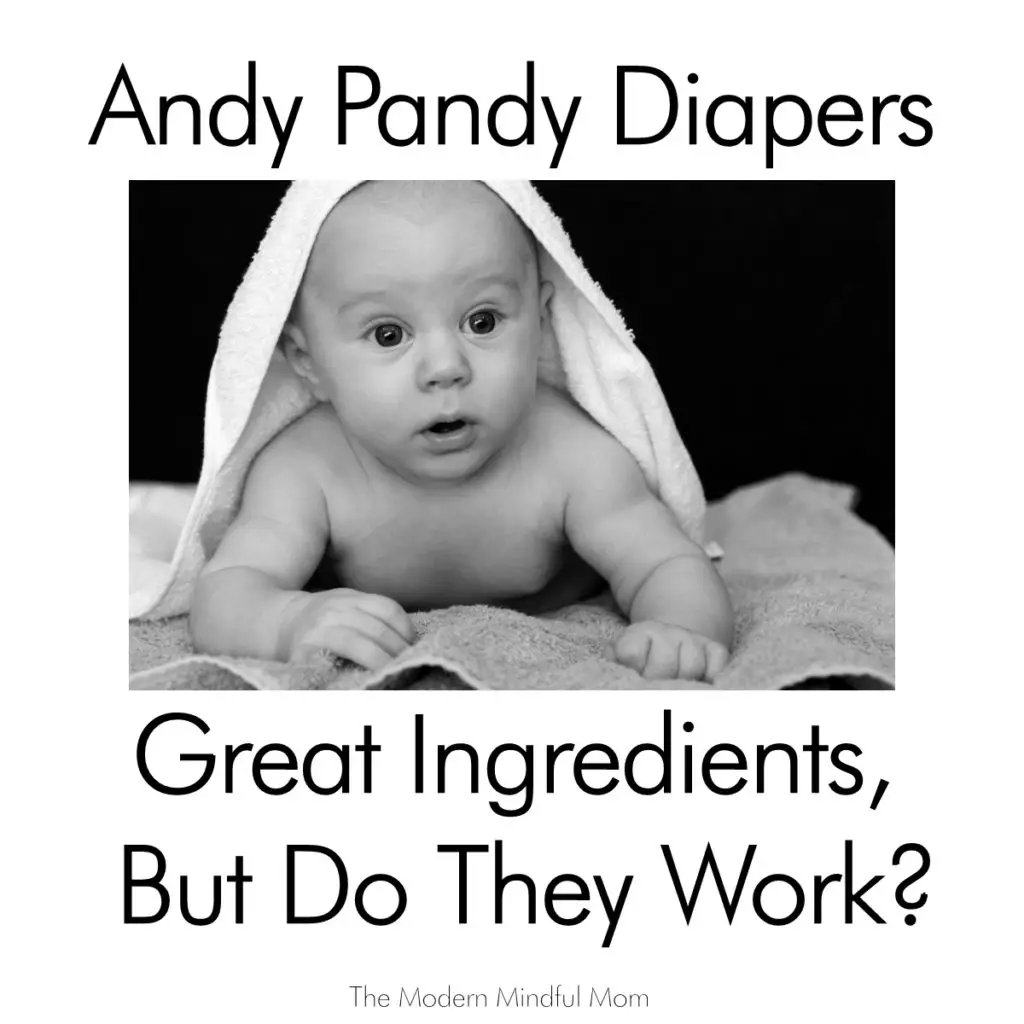
So we’ve established that the Andy Pandy Premium Bamboo diapers have safe, non-toxic ingredients, but do they actually work?
Yes!
When it comes to diapers, they need to not only look good on paper, but perform! And these diapers do just that!
I have been using these diapers almost exclusively. Blow-outs and leaks are extremely rare. My little one has never had a diaper rash.
I swear by the performance of these diapers. When friends are experiencing leaks, I excitedly jump to tell them about Andy Pandy. When friends are experiencing diaper rashes, same thing. I am so excited to share about Andy Pandy because of their safe ingredients and effective performance. I truly believe the two go hand in hand.
Buying Andy Pandy Diapers | What You Need to Know
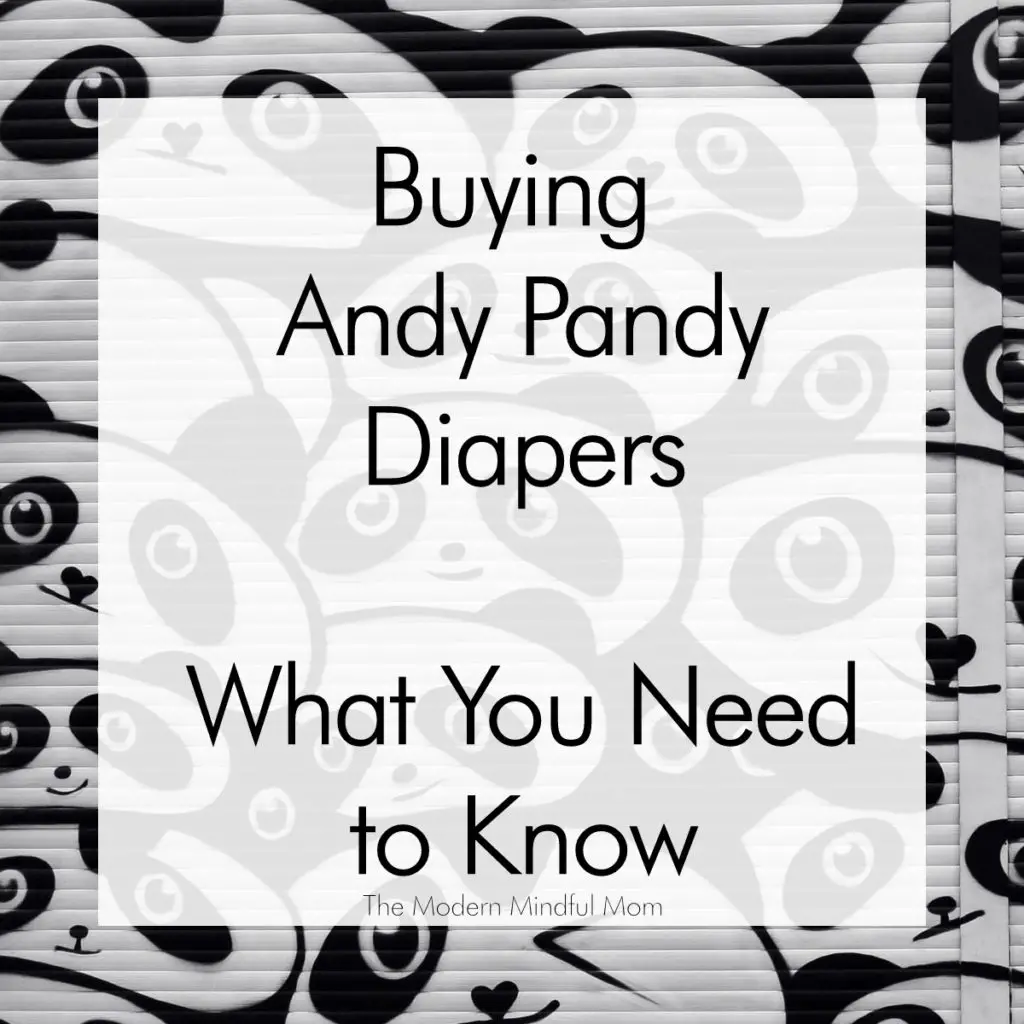
Sizing
The biggest thing you’ll notice is that Andy Pandy diapers don’t follow the conventional diaper sizing (1, 2, 3, etc.). Here are their sizes for the recommended weight of your child:
| Size | Weight |
| Newborn | 5-10 lbs (2-4 kg) |
| Small | 6-16 lbs (3-8 kg) |
| Medium | 13-22 lbs (6-10 kg) |
| Large | 20-31 lbs (9-14 kg) |
| XL | 26+ lbs (12 kg above) |
Where to Buy Andy Pandy Diapers
Andy Pandy diapers can be bought from their website AndyPandyKids.com or from Amazon. They also can be found at some independent retailers.
Price
Below are the prices of Andy Pandy diapers by size, as well as price per diaper. Andy Pandy also offers a “subscribe and save” discount on their website, which is definitely worth it! (The Amazon prices may vary slightly).
| Size | Count | Subscribe & Save Price | Subscribe & Save Price Per Diaper | Original Price | Price Per Diaper |
| Newborn | 50 | $18.00 | 36 cents | $18.95 | 40 cents |
| Small | 94 | $35.10 | 37 cents | $36.95 | 39 cents |
| Medium | 80 | $35.10 | 44 cents | $36.95 | 46 cents |
| Large | 70 | $35.10 | 50 cents | $36.95 | 53 cents |
| XL | 62 | $35.10 | 57 cents | $36.95 | 60 cents |
Hopefully you found this informative and helpful! If you try Andy Pandy diapers, I hope you’ll love them as much as I do!
Related:
